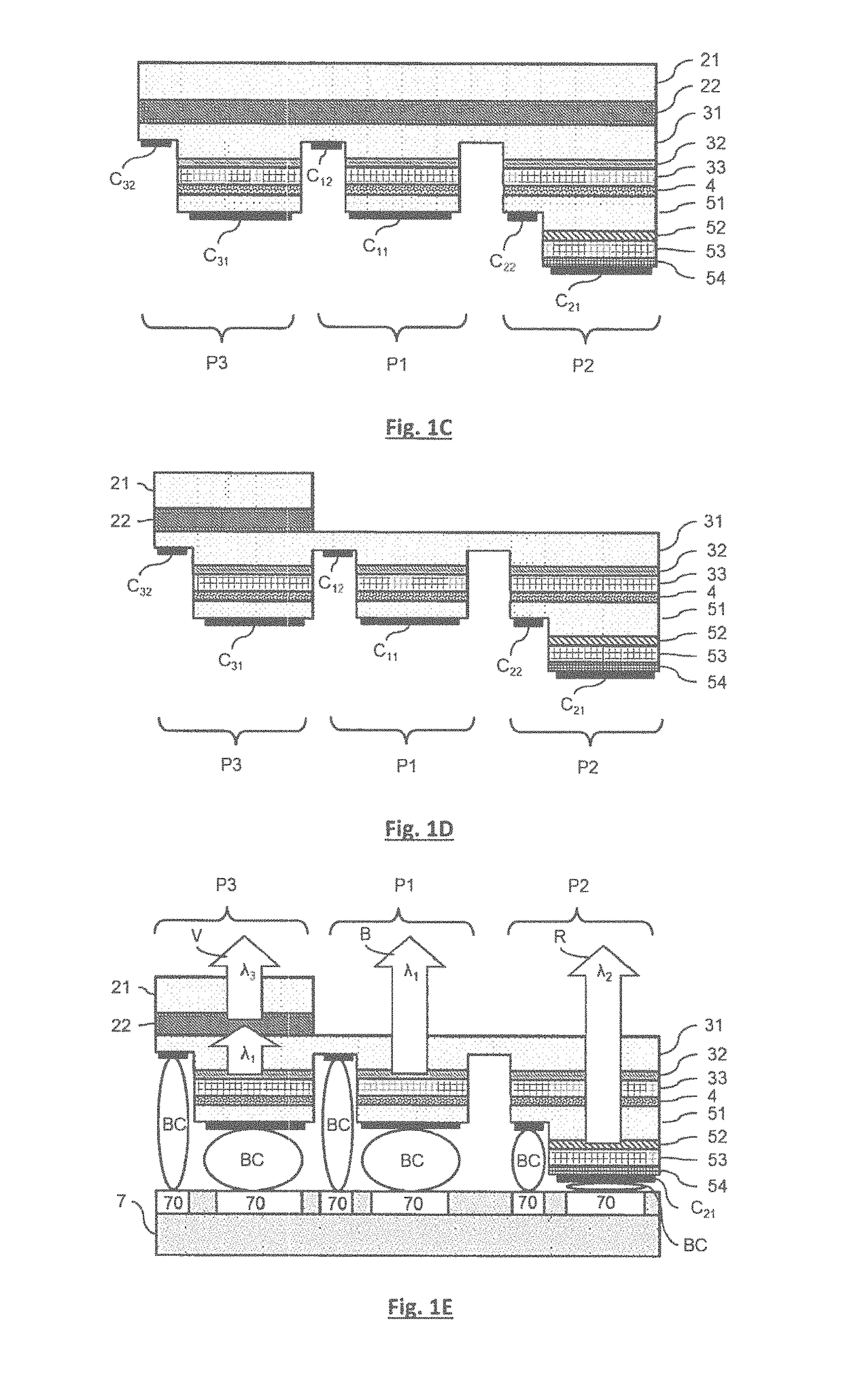Semiconducting pixel, matrix of such pixels, semiconducting structure for the production of such pixels and their methods of fabrication
a technology of semiconductor pixel and matrix, which is applied in the field of semiconductor pixel, can solve the problems of non-negligible overhead of using three different leds, low luminance of oleds for certain applications, and miniaturization problems, and achieves the effects of less loss, high luminosity, and simple hybridization
- Summary
- Abstract
- Description
- Claims
- Application Information
AI Technical Summary
Benefits of technology
Problems solved by technology
Method used
Image
Examples
first embodiment
[0054]FIG. 1A shows an epitaxial monolithic structure that can be used as starting point for a method for fabricating a semi-conducting pixel according to the invention. This structure comprises, from the bottom:
[0055]A substrate 1, made for example of sapphire; this substrate will be eliminated in the course of the fabrication method, consequently its nature is of only little importance, provided that it allows the epitaxial growth of the other layers constituting the structure. Thus in place of sapphire it would be possible to use, for example, a substrate made of Si, SiC or ZnO.
[0056]A first subset of semi-conducting layers 2 comprising, in order, a layer 21 of type n doped GaN, for example of thickness equal to 2 μm, having solely an electrical conduction function, and an “active” (that is to say light-emitting) layer 22 comprising a stack of quantum wells (Ga,In)N / (Al,Ga,In)N, also exhibiting a doping of type n or not intentionally doped and able to emit a green luminous radiat...
second embodiment
[0079]FIGS. 2A-2E illustrate the fabrication of a pixel according to the invention, comprising an added wavelength converter, emitting in the red.
[0080]The starting point of such a method (FIG. 2A) is a structure similar to that of FIG. 1A but not comprising the layers 21 and 22; in this structure, the layer 31 is deposited directly on the substrate. Furthermore, the active layer furthest from the substrate (reference 52′) is adapted for emitting a green radiation, instead of a red radiation like the active layer 52 of FIGS. 1A-1E. In FIG. 2A, the reference 3′ identifies a first stack of semi-conducting layers, comprising the layers 31, 32 and 33, and substantially identical to the second stack 3 of FIG. 1A; the reference 5′ identifies a second stack of semi-conducting layers comprising the layers 51, 52′, 53 and 54.
[0081]The first steps of etching (FIG. 2B), inversion and elimination of the substrate (FIG. 2C) are substantially identical to the corresponding steps of the above-desc...
PUM
 Login to View More
Login to View More Abstract
Description
Claims
Application Information
 Login to View More
Login to View More - R&D
- Intellectual Property
- Life Sciences
- Materials
- Tech Scout
- Unparalleled Data Quality
- Higher Quality Content
- 60% Fewer Hallucinations
Browse by: Latest US Patents, China's latest patents, Technical Efficacy Thesaurus, Application Domain, Technology Topic, Popular Technical Reports.
© 2025 PatSnap. All rights reserved.Legal|Privacy policy|Modern Slavery Act Transparency Statement|Sitemap|About US| Contact US: help@patsnap.com



